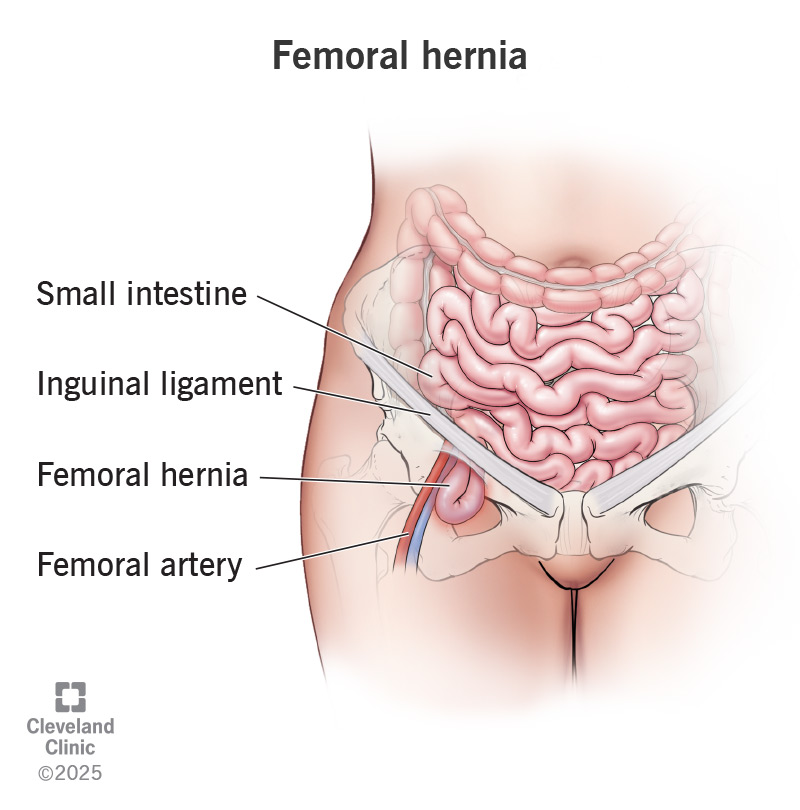A femoral hernia is a rare hernia in your upper thigh, just above the crease in your groin. This hernia type happens when tissue or intestine pokes through muscles and into your femoral canal. It may not cause symptoms. When it does, symptoms are abdominal pain and a bulge in your groin or upper thigh. Treatment is surgery to repair the hernia.
Advertisement
Cleveland Clinic is a non-profit academic medical center. Advertising on our site helps support our mission. We do not endorse non-Cleveland Clinic products or services. Policy

A femoral hernia is a rare type of hernia. It develops in your inner upper thigh above the crease in your groin. Females are more likely to have femoral hernias than males.
Advertisement
Cleveland Clinic is a non-profit academic medical center. Advertising on our site helps support our mission. We do not endorse non-Cleveland Clinic products or services. Policy
This hernia type may not cause symptoms. You may learn you have a femoral hernia after a routine physical examination. But femoral hernias can lead to more serious hernia issues. Your healthcare provider may recommend surgery to repair it.
You may not have symptoms. If you do, they may include:
You may notice your symptoms get worse when you stand for a long time, lift heavy objects or strain to poop or pee.
You can have a femoral hernia if tissue or a piece of intestine pushes through muscles in your lower abdomen. The hernia moves into the femoral canal that contains your femoral artery.
You may be born with a femoral hernia. The hernia may form during fetal development. But most femoral hernias happen when something puts pressure on your lower abdominal muscles. That can happen if you lift or push heavy objects. It may also happen if you:
A femoral hernia may get stuck in your femoral canal (incarcerated hernia). Pressure on it can affect blood flow to tissue inside the hernia (strangulated hernia). A strangulated hernia is a medical emergency.
Advertisement
A healthcare provider will do a physical exam. They’ll ask if the bulge in your groin or upper thigh comes and goes. They may ask if the bulge appears when you do things like straining to poop or lifting heavy objects.
They may do tests to rule out other conditions that cause femoral hernia symptoms. Those tests may include MRI, CT scan or ultrasound. Conditions that may be mistaken for a femoral hernia include:
Treatment is hernia repair surgery. Surgery reduces your risk of complications like an incarcerated or strangulated hernia.
Hernia repair surgery cures a femoral hernia. But you can develop another one. Ask your surgeon if there’s a chance you’ll have another femoral hernia. They may recommend routine follow-up exams. That way, you and your provider can make sure you don’t have another femoral hernia and need more treatment.
Weak lower abdominal muscles increase the risk you’ll have a femoral hernia. Protecting and strengthening those muscles may prevent one. Here are some suggestions:
Talk to your provider if you have a femoral hernia and develop symptoms of an incarcerated hernia. Symptoms may include:
An incarcerated femoral hernia may become strangulated. That means blood can’t get to the tissue or intestine inside a femoral hernia. A strangulated hernia is a medical emergency. Call 911 (or your local emergency service number) or go to the emergency room if the skin around a femoral hernia turns reddish or darker than usual.
Your routine physical exam and follow-up test shows you have a femoral hernia. You don’t have symptoms. So, it may be surprising when your healthcare provider recommends surgery. But this rare type of hernia often leads to serious complications. Surgery to fix the hernia is the only way to cure it and avoid these complications.
Advertisement
You may wonder what to expect after surgery. Don’t hesitate to ask your provider. They’ll be glad to answer your questions.
Advertisement
Hernias can be painful – Cleveland Clinic’s experts can help. We are leaders in minimally invasive hernia repair, and abdominal wall reconstruction.

Last reviewed on 05/09/2025.
Learn more about the Health Library and our editorial process.